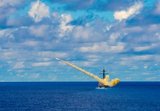Japan successfully fires electromagnetic railgun
The railgun can fire projectiles at a speed of Mach 6.5, according to ATLA. (Photo: ATLA via Twitter/X)
Japan successfully test-fired an electromagnetic railgun from a ship on 17 October, a world first and a major step in a process worth billions of Yen.
The Acquisition, Technology, and Logistics Agency (ATLA) of Japan's Ministry of Self Defence announced the success of the test on Twitter/X stating: ‘ATLA has accomplished ship-board firing test of railgun for first time in the world with the cooperation of the Japanese Marine Self-Defence Force.’
The announcement highlighted the main role of the system is to ‘protect vessels against air threats and surface threats by high-speed [munitions].’
In May 2022, the ATLA's Ground Systems Research Centre concluded a JPY6.5 billion ($47.9 million) contract with Japan Steel Works to research and prototype a railgun. Also in May, ATLA said a further contract of JPY16 billion would be inked.
Securing electrical power is a practical issue in the application of railguns. To this end, ATLA signed a JPY3.7 billion contract with Japan Steel Works to downsize power supply units and capacitors.
The ATLA railgun uses five megajoules (MJ) of charge energy and achieved a speed of about 2,230m/s or Mach 6.5 in a 2018 test. Ultimately, ATLA has said it intends it to run on 20MJ.
Other countries have walked away from railgun technology but Japan remains committed. In May, Japan announced it had developed a prototype medium railgun of 40mm calibre to research how to achieve higher initial velocity and longer barrel life.
The rail’s endurance is more than 120 rounds and can fire a projectile weighing 320gm. It has, however, been a long road with ATLA beginning research on a small 16mm-calibre railgun in 1990.
ATLA said the railgun would be mounted on a destroyer or truck to intercept hypersonic guided missiles and attack naval vessels and ground targets, despite the difficulties for a Mach 6.5 projectile with no guidance system to effectively intercept hypersonic-guided missiles flying at Mach 5-10 speeds.
More from Naval Warfare
-
![NATO tests use of “undetectable, jam-proof” laser communication in maritime scenarios]()
NATO tests use of “undetectable, jam-proof” laser communication in maritime scenarios
As part of its effort to better prepare its capabilities for operations in contested and congested scenarios, NATO evaluated a Lithuanian ship-to-ship terminal designed to not be susceptible to enemy interference.
-
![Future of the Canadian Patrol Submarine Project is still unclear]()
Future of the Canadian Patrol Submarine Project is still unclear
The Canadian government remains tight-lipped on the timeline and funding required for the next steps of its Canadian Submarine Patrol Project, which should offer improved capabilities for the country’s navy.
-
![Mitsubishi eyes future with Australia’s Mogami selection]()
Mitsubishi eyes future with Australia’s Mogami selection
With Australia’s selection of the Mogami-class for Project Sea 3000, Mitsubishi is investigating local production in the next decade as potential export opportunities emerge.
-
![Thales’ new Sonar 76Nano could equip UK Royal Navy on anti-submarine warfare missions]()
Thales’ new Sonar 76Nano could equip UK Royal Navy on anti-submarine warfare missions
The new sonar is designed to equip uncrewed underwater vessels, with the potential to be used by the Royal Navy for its Atlantic Bastion and Atlantic Net missions.























